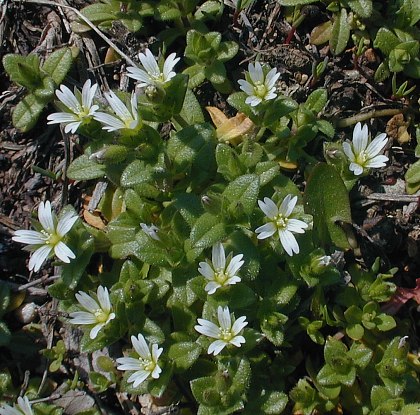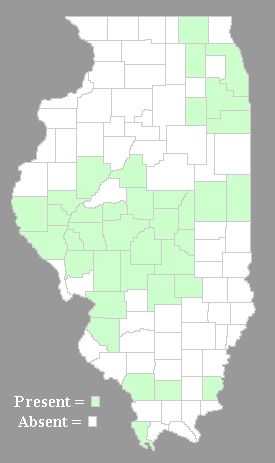Description: This little plant is a winter or spring annual about 2-6" tall. A mature plant becomes tufted at the base, sending up multiple stems. These stems are green and pubescent. The opposite leaves are up to ¾" long and about half as much across. These leaves are broadly oblong or ovate-oblong, green, and pubescent; they have conspicuous central veins, smooth margins, and sessile bases.

The upper stems
terminate in small cymes or individual flowers; sometimes the lower
cymes branch into secondary cymes of flowers. The peduncles and
pedicels of these cymes are light green and pubescent. At the base of
each peduncle, there is a pair of green leaf-like bracts. These bracts
are broadly lanceolate-oblong or lanceolate-ovate, pubescent, and
smooth along the margins; some of the upper bracts have thin
translucent margins toward their tips (i.e., they are slightly
scarious). These translucent margins are more apparent in mature or
dried-out plants than young specimens. The flowers at the tips of the
pedicels are up to ¼" across when they are fully open. Each flower has
5 white petals, 5 green sepals, 5 white styles, and 5 stamens with pale
yellow anthers. Each petal has several pale lines at its base, while
its tip is notched. The sepals are lanceolate and hairy; their margins
are translucent. The blooming period occurs during the spring and lasts
about 1 month; this is one of the earliest wildflowers to bloom during
the spring. The flowers open up during spring days that are sunny and
warm. Some plants begin to bloom when they are only 1" tall. Each
flower is replaced by a cylindrical capsule containing many small
seeds. Each seed capsule is straight to slightly curved; there are 10
small teeth along its upper rim. The seeds are brown, somewhat
flattened, and minutely warty or pebbly. The root system consists
mostly of thin fibrous roots. This plant spreads by reseeding itself
and it often forms small colonies.
small
seeds. Each seed capsule is straight to slightly curved; there are 10
small teeth along its upper rim. The seeds are brown, somewhat
flattened, and minutely warty or pebbly. The root system consists
mostly of thin fibrous roots. This plant spreads by reseeding itself
and it often forms small colonies.
Cultivation:
The preference is full sun, moist to slightly dry conditions, and
sterile soil with little ground vegetation. In Illinois, this little
plant completes its growth cycle during the spring.
Range & Habitat:
Small Mouse-Eared Chickweed is occasional in central and NE Illinois,
while in other areas of the state it is uncommon or absent. This plant
was accidentally
introduced into the United States from Europe. Habitats consist of
fields, disturbed grassy meadows, areas along roads, barren ground in
lawns, and waste areas. Areas with a history of disturbance and
environmental degradation are strongly preferred. This little plant
tolerates road salt and other run-off chemicals better than most kinds
of turf-grass; it also tolerates hardpan clay and gravel better than
turf-grass.
Faunal Associations:
Like other Chickweeds (Cerastium spp., Stellaria
spp.), the flowers of this species attract small bees and
Syrphid flies. While the foliage of Small Mouse-Eared Chickweed is
potentially edible to rabbits, it is rarely eaten because of its
diminutive size and early spring growth. Small granivorous songbirds
(e.g., sparrows) may use the seeds as a minor source of food.
Photographic Location:
A barren area along a roadside in Urbana, Illinois.
Comments:
There are several Cerastium spp. (Mouse-Eared
Chickweeds) in Illinois and they are difficult to distinguish from each
other. I believe that the species in the photograph above is Cerastium
pumilum (Small Mouse-Eared Chickweed) for the following
reasons: 1) It is a short-lived annual that completes its life-cycle
during the spring, 2) Each of its flowers has 5 stamens and 5 styles,
3) Its flowers always have 5 petals, and 4) Its floral bracts usually
lack translucent margins, except for some of the upper bracts on mature
plants. Other Mouse-Eared Chickweeds are perennials (e.g., Cerastium
fontanum), or they have flowers with 10 stamens (e.g., Cerastium
brachypetalum, Cerastium glomeratum), or
they produce flowers with 4 petals (e.g., Cerastium diffusum),
or all of their bracts have conspicuous translucent margins (e.g., Cerastium
semidecandrum).